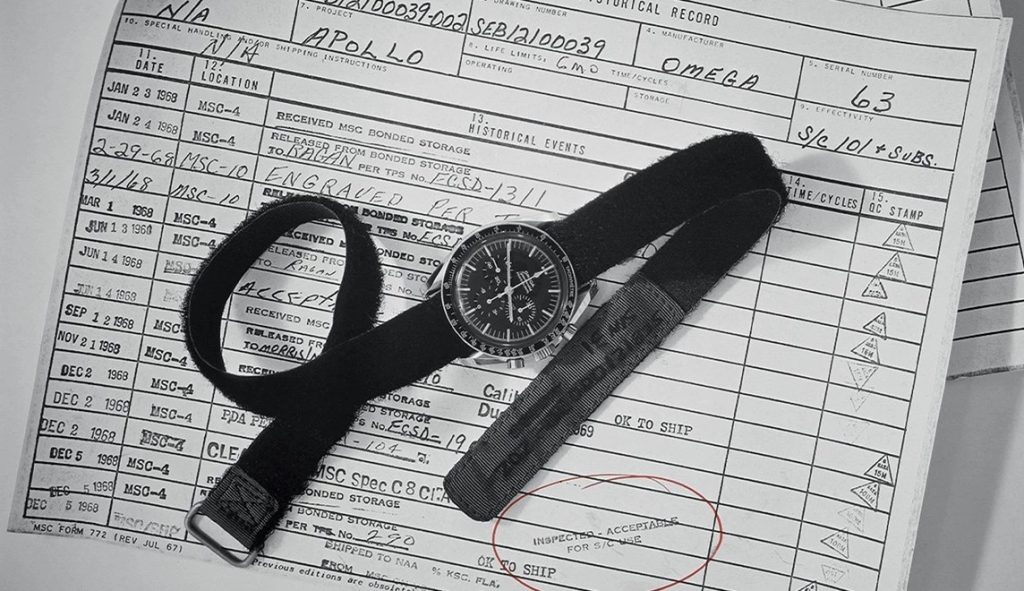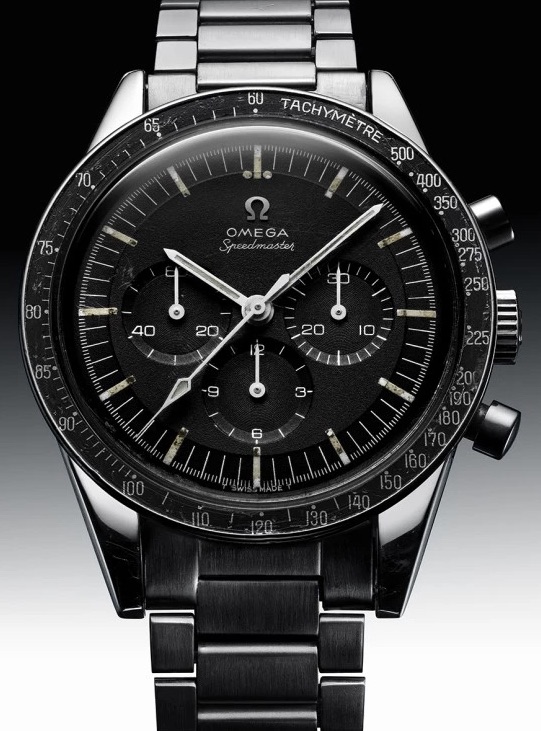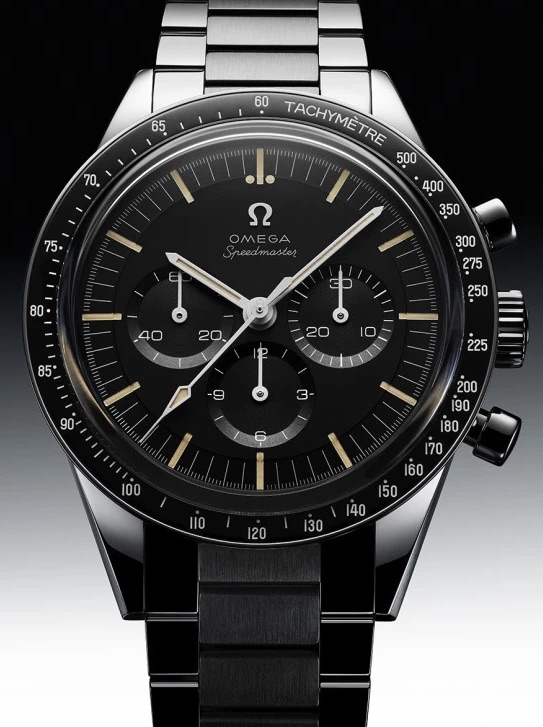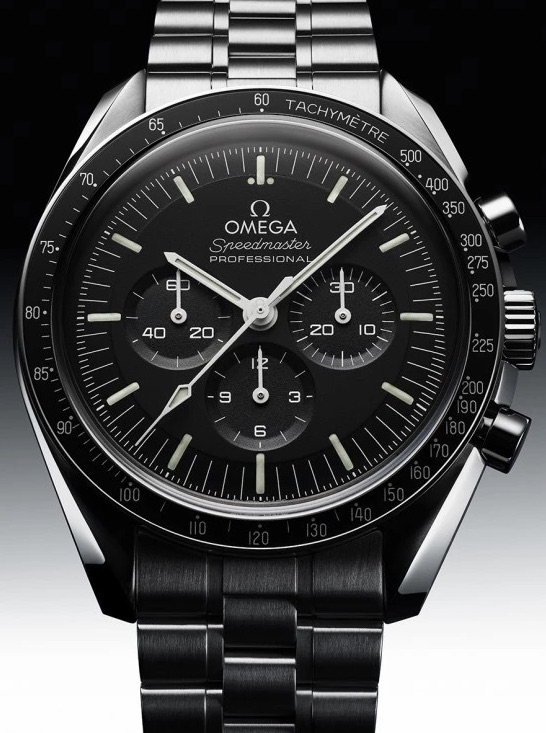On the 1st of March 1965, NASA declared the OMEGA Speedmaster to be “Flight Qualified for all Manned Space Missions.” This pivotal day was the official beginning of OMEGA’s extraordinary journey beyond Earth, which has since included every Moon landing in history and many of the greatest missions of our time.
The NASA qualification is synonymous with OMEGA’s pioneering spirit and excellence in design. 60 years after the approval was announced, the brand is looking back to that hopeful era of human adventure, and celebrating the moment that its AAA UK replica watches became part of the story.
The Background
In 1962, US President, John F. Kennedy, stood in front of an audience at Rice University and famously declared, “We choose to go to the Moon.” Most ambitious of all, he promised to achieve that goal in the very same decade.
The USA’s race into space was ignited.
Project Mercury was the country’s first human spaceflight programme, and became known for its brave group of pilots named The Mercury Seven. When the programme ended in 1963, the NASA astronauts approached their Operations Director, Deke Slayton, and asked to be issued with a reliable watch for future missions.
The high quality fake watches were required as a backup. If the astronauts lost the capability of their digital timers onboard the spacecraft, the only thing they would have to rely on would be the mechanical timepieces they wore. Therefore, quality was essential.
NASA was already re-evaluating its equipment for the upcoming Gemini and Apollo missions, so in 1964, Slayton issued a request for “high-quality chronographs” and forwarded it to a number of different watch brands.
Of all those brands who received Deke Slayton’s letter, only four responded – including OMEGA. Each company was asked to send “three wristworn chronographs”, which would be tested under the most intense examinations imaginable.
The Testing
Any piece of hardware that went on the space vehicles had to be qualified by the safety, reliability and quality controllers at NASA.
Engineer, James Ragan, was the man in charge of testing the cheap 1:1 copy watches. During his 36-year aerospace career, one of his vital responsibilities was to examine and certify the astronaut chronographs used on NASA’s manned missions.
When James Ragan received the watches from the four brands, he excluded one straight away, because it wasn’t a capable wristwatch like NASA had specified.
In the end, top replica watches from three different brands were tested. To succeed – each watch had to pass all 11 tests.
High Temperature Test
After enduring 48 hours at 70° C, the perfect fake watches UK then faced 30 minutes at 93° in a partial vacuum. It was at this stage, in the thermal vacuum, that the watches from two other brands failed. The OMEGA Speedmaster was the only watch still surviving.
Low temperature Test
The watch spent 4 hours in an environment of -18° C.
Vacuum Test
The watch was heated in a vacuum chamber and then immediately cooled to -18° C for several cycles.
Humidity Test
An environment of 95% humidity was created with temperatures ranging from 25° C to 70° C. The watch was required to survive it during ten 24-hour cycles.
Corrosion Test
The watch faced 48 hours in an atmosphere of oxygen at 70° C.
Shock-Resistance Tests
Replicating the severity of space travel, the watch faced six 40 G shocks in six different directions.
Acceleration Test
The watch endured a progressive acceleration to 7.25 G for about five minutes and then to 16 G for 30 seconds in three axes.
Low Pressure Test
The watch was subjected to a pressure of 10-6 atmospheres at 70° C for 90 minutes, then at 93° C for 30 minutes.
High Pressure Test
The watch was subjected to an air pressure of 1.6 atmospheres for 60 minutes.
Vibration Test
To simulate the extremes of a spacecraft launch, the watch faced random vibrations in three axes between 5 and 2,000 Hz with an acceleration of 8.8 G.
Sound Test
To ensure reliability against noise, the watch was subjected to 130 decibels at frequencies from 40 to 10,000 Hz for 30 minutes.
The Astronaut Approved Result
The OMEGA Speedmaster ST 105.003 passed all 11 tests with success. This was the exact same model available to customers in stores.
The luxury replica watches from other brands, however, were eliminated during the high temperature test. On one brand’s watch, the large seconds hand warped and was binding against the other hands. On another brand’s watch, the crystal of the chronograph warped and came away from the case.
Speaking about the Speedmaster’s success, James Ragan said, “Even I was surprised that I could get any watches through those tests. The environments were really made for pieces of hardware that you mount on vehicles. It was difficult. It was the most extreme testing you could do to a piece of hardware.”
But there was one final test for qualification, and it was perhaps the most important of all. The best super clone watches also needed to be personally approved by the astronauts themselves.
Ragan gave the crews the Speedmaster and other watches to examine and evaluate. Not knowing the results of the tests, the astronauts came back and unanimously chose the Speedmaster as their preferred model, due to the better accuracy, reliability, readability and ease of operation.
Ragan later said, “It made my life a lot easier. I was able to go to the programmes office and say, it’s passed the tests and the astronauts want it.”
What Happened Next?
Just three weeks after the qualification was granted, on the 23rd of March, 1965, the Speedmaster ST 105.003 officially went into space for the first time on the wrists of Virgil “Gus” Grissom and John Young during their Gemini 3 mission. The only modification to the watches was the addition of a long Velcro strap that could be worn over the space suits.
Beyond Gemini 3, the Swiss made replica Omega Speedmaster watches and its various updates became an invaluable tool for the crews aboard each of NASA’s manned missions. Famously, it was worn by Ed White during the first American spacewalk in 1965 and also the crew of Apollo 8, who saw the “far side of the Moon” for the first time in 1968.
As the Speedmaster continued to serve the astronauts in space, NASA got closer and closer to its major goal. Finally, on the 20th of July 1969, Apollo 11 touched down on the moon for the first time in history, fulfilling John F. Kennedy’s promise.
Neil Armstrong and Buzz Aldrin spent two and a half hours walking on the lunar surface, and in that moment, the OMEGA Speedmaster became the first watch worn on the Moon. It has returned for every Moon landing since then and long remained a critical part of NASA’s astronaut kit.
An Enduring Design
At first glance, the Swiss movements fake Omega Speedmaster watches produced over the past 60 years appear almost unchanged. Afterall, why adapt something that is so iconic and loved? However, look a little closer, and you’ll discover the critical evolutions and similarities that are available to customers today.
NASA Tested Watch ST 105.003
Size : Qualified by NASA in 1965, this model represents the Speedmaster’s 3rd generation design and is sized at 39.70 mm.
Caseback : This early Omega Speedmaster replica watches wholesale featured a double bevel caseback with “Speedmaster” engraved and OMEGA’s famous Seahorse emblem.
Bracelet : The Speedmaster 105.003 was delivered on several linked bracelet references, while also being presented on Velcro straps when astronauts wore it over their spacesuits. The style seen in this image features 3 flat links per row and a protruding OMEGA vintage logo on the clasp to help with opening.
Dial : While the black dial featured an applied OMEGA logo in the vintage style, it also included tritium markers for luminosity. Note especially that this was the last Speedmaster reference that did not include the addition of the word, “Professional”.
Tachymeter Bezel : It wouldn’t be a Speedmaster without a tachymeter scale on the bezel. For dedicated fans, two small but recognizable details of the ST 105.003 are the placement of the dot over 90, and the dot diagonal to 70.
Pushers : The pushers on the NASA tested watch were considered medium size and very easy to use with thick astronaut gloves. Notably, they are without the protection of the asymmetrical case that modern versions offer.
Case Shape : The shape of the NASA-tested watch is most notable for its symmetrical shape with straight lugs. This was the last Speedmaster that came without crown guards. From this generation onwards, it became known as the Moonwatch after its historic lunar landing.
Calibre : The iconic Calibre 321 was robust and elegant, and contained an intricate and technically valuable column-wheel feature. For collectors, it has become one of the world’s most essential pieces of watchmaking art.
The Speedmaster Calibre 321 311.30.40.30.01.001
Size : Inspired by the 3rd generation Speedmaster that NASA qualified in 1965, OMEGA launched this 39.70 mm choice in 2020 for modern customers – almost perfectly replicating the original style.
Caseback : To let customers admire the sophisticated me- chanics of the Calibre 321, OMEGA gave this model a transparent sapphire crystal caseback.
Bracelet : A modern version of the bracelet with 3 flat links has been used for the Speedmaster Calibre 321. A foldover clasp fastens it to the wrist.
Dial : This black step dial remains as true to the original as possible, with similar features including the vintage OMEGA logo and the same Speedmaster font. Naturally, to give it a necessary update, the markers are coated in modern Super-LumiNova instead of tritium.
Tachymeter Bezel : Naturally, the important placement of the dots hasn’t been changed for the Speedmaster Calibre 321. What’s new, however, are the materials used. Instead of the original aluminium bezel ring, OMEGA has created a bezel ring in polished black ceramic with the tachymeter scale in white enamel.
Pushers : The very same pushers still remain – proving that some designs are too perfect to change.
Case Shape : The straight lugs and symmetrical case are the same as the original NASA tested copy watches shop. Just like that model, today’s tribute also includes the same brushed sides and polished upper surfaces.
Calibre : The original Calibre 321 was used by OMEGA until 1969. Then, in 2019, it made a triumphant return – after two years of relentless research and development. To reconstruct the movement as accurately as possible, OMEGA employed an entire group of researchers, developers and historians, as well as the finest craftsmen and experienced watchmakers. Going even further, they also used “tomography” technology (a digital scanning method) to see inside the true Speedmaster ST 105.003 timepiece that astronaut Eugene “Gene” Cernan wore on the Moon during Apollo 17.
The Speedmaster Moonwatch 310.30.42.50.01.001
Size : Perhaps the most iconic chronograph on Earth, today’s luxury China replica Omega Speedmaster Moonwatches is 42 mm, and is inspired by the 4th generation style that Apollo 11 astronauts wore on the Moon. This latest Co-Axial Master Chronometer version was launched in 2021.
Caseback : The caseback of the Moonwatch includes the famous words; “FLIGHT-QUALIFIED BY NASA FOR ALL MANNED SPACE MISSIONS”, as well as “THE FIRST WATCH WORN ON THE MOON”. The Seahorse emblem still retains its place at the centre. Since 2021, with the introduction of the Calibre 3861, the text “Co-Axial Master Chronometer” has also been added, highlighting the movement inside.
Bracelet : Today’s Moonwatch bracelets are presented with five arched links per row, with a foldover clasp and an additional comfort setting.
Dial : The black step dial of the Moonwatch features a transferred logo with the addition, since 1964, of the word “Professional”. From 1997, the models were upgraded with Luminova detailing for better visibility. The logo and Speedmaster font are also in keeping with today’s modern style.
Tachymeter Bezel : The Swiss online fake Omega Speedmaster Moonwatches features an anodised aluminium bezel ring in black, a feature that has been part of the design since the Speedmaster’s 2nd generation. Almost everything else is exactly as it was in 1964. A perfect tool for measuring speed over a known distance. Although the positioning of the 90 and 70 dots on the bezel were changed over the years, they have now been returned to their original placement as a tribute to heritage.
Pushers : The most interesting feature of the Moonwatch pushers today is the protection they are given by the asymmetrical case.
Case Shape : The Moonwatch case is inspired by the 4th generation Speedmaster. It features twisted lugs, as well as an asymmetrical shape that provides protection for the crown and pushers.
Calibre : The Calibre 3861 is the most up-to-date descendant of the Calibre 321. Compared to previous versions, it offers improved power reserve, chronometric performance and magnetic resistance. Many innovative features include OMEGA’s revolutionary Co-Axial escapement as well as the silicon Si14 balance spring. These advancements enable the watch to pass the eight Master Chronometer tests.
The Speedmaster Difference
Accuracy, reliability, readability and ease of operation were the reasons given by astronauts, when asked about their preference for their Speedmaster. Indeed, the timepieces offered numerous qualities that many other replica watches for sale could not.
Robust Design
When the original Speedmaster was created in 1957, it included many protective technologies used by OMEGA at the time, such the sealing powers of O-ring gaskets, and the famous “Naiad” crown. Through this, OMEGA was able to create an incredibly rugged chronograph that was hermetically sealed against the elements and whose sealing powers extended to a depth of 200 feet. Furthermore, the hesalite glass offered the advantage of flexibility, and therefore shatter-resistance, in high impact situations. The last thing an astronaut wants during a mission is tiny fragments of glass floating in the spacecraft.
Pioneering Spirit
The Speedmaster was a design pioneer. When released in 1957, it became the first fake watches store to feature a tachymeter scale on its bezel, as opposed to the dial. This made it ideal for its intended customer – racing car drivers out on the track. Ever since then, the iconic timing scale has remained an essential and distinguishing element of the Speedmaster design.
Readability
The original Speedmaster from 1957 was engineered for racing car drivers. Therefore, the design was given an easily readable face, so that timing could be noted at a glance. Not only did this theme continue in the ST 105.003, but there was also luminosity on the baton hands and hours markers, provided by the use of tritium. For the darkest reaches of space, this distinctive readability was a critical factor.
Accuracy
By 1965, OMEGA had a superb reputation for precision, and especially for chronograph design. The brand’s first chronograph calibre with 30-minute and 12-hour counters was the 27 CHRO C12. First designed and produced in 1941, it was a movement distinguished by its use of a column wheel, a feature that was machined from a single piece and which added technical value. This led to the birth of the Calibre 321, given its name in 1949. Using the same column wheel system, it encapsulated OMEGA’s commitment to accuracy, and its expertise in ultra-fine mechanics.




